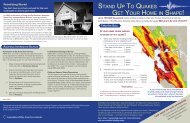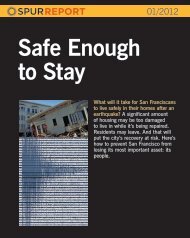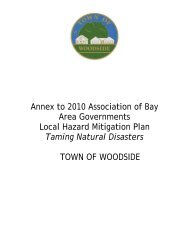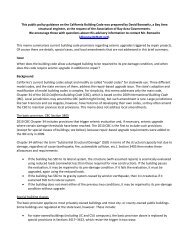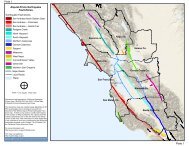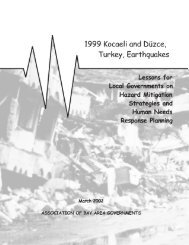Airport Liquefaction Susceptibility Analysis Report - ABAG ...
Airport Liquefaction Susceptibility Analysis Report - ABAG ...
Airport Liquefaction Susceptibility Analysis Report - ABAG ...
You also want an ePaper? Increase the reach of your titles
YUMPU automatically turns print PDFs into web optimized ePapers that Google loves.
Fugro Consultants, Inc.<br />
Project No. 04.79221200<br />
EXECUTIVE SUMMARY<br />
The Association of Bay Area Governments (<strong>ABAG</strong>), under a grant issued by the California<br />
Department of Transportation (CalTrans), is revising and updating their 1999 earthquakeinduced<br />
liquefaction susceptibility assessments of San Francisco International <strong>Airport</strong> (SFO)<br />
and Oakland International <strong>Airport</strong> (OAK), as well as performing new assessments at three<br />
smaller general aviation regional airports; Moffett Federal Airfield (Moffett), located in<br />
Sunnyvale; Buchanan Field <strong>Airport</strong> (Buchanan), located in Concord; and Livermore Municipal<br />
<strong>Airport</strong> (Livermore), located in Livermore. These assessments are part of a larger planning<br />
study to evaluate the use of and access to these facilities following a hypothetical largemagnitude<br />
earthquake. Fugro Consultants, Inc. (FCL) is collaborating with <strong>ABAG</strong> to assess the<br />
susceptibility to liquefaction at each of these five airports.<br />
<strong>Liquefaction</strong> is the transformation of a granular material from a solid state into a liquefied state<br />
as a consequence of increased pore pressure and decreased effective stress (Youd, 1973).<br />
Increased pore pressures in unconsolidated sediment, especially in west-central California, are<br />
typically earthquake-induced (co-seismic). <strong>Liquefaction</strong> related ground failure can result in<br />
settlement, foundation (bearing) failure, lateral movement (lateral spread), and general ground<br />
cracking. <strong>Airport</strong> runway surfaces are susceptible to damage and closure following liquefactionrelated<br />
ground failure. In this study, FCL develops earthquake-induced liquefaction hazard<br />
maps following the general liquefaction susceptibility hazard analyses and mapping approach of<br />
the California Geological Survey and based on current and recent research studies performed<br />
by FCL and former William Lettis and Associates (WLA) in California.<br />
Eathquake-induced liquefaction-related ground failures historically have caused extensive<br />
structural and lifeline damage in urbanized areas around the world. Recent examples of these<br />
effects include damage produced during the 1994 Northridge (California), 1995 Kobe (Japan),<br />
1999 Izmit (Turkey), 2001 India earthquakes, and also the 2010-2011 Christchurch earthquake<br />
sequence (New Zealand). Damaging liquefaction occurred in the San Francisco Bay Area<br />
during the 1868 Hayward earthquake, the 1906 San Francisco earthquake, the 1957 Daly City<br />
earthquake, and the 1989 Loma Prieta earthquake (Youd and Hoose, 1978; Holzer, 1998).<br />
Studies of historical earthquakes show that the areal distribution of liquefaction-related damage<br />
is generally restricted to alluviated basins and filled land areas that contain shallow layers of low<br />
density, saturated, granular sediment (e.g. Youd and Hoose, 1978; Holzer, 1998; Tinsley et al.,<br />
1985). In the areas around San Francisco Bay, the geologic materials with a history of<br />
liquefaction include Holocene-aged estuarine deposits, Holocene stream and alluvial fan<br />
deposits, Holocene and Pleistocene eolian deposits, and artificially emplaced fill materials.<br />
Understanding the distribution and extent of these materials is critical to understanding the<br />
potential hazard posed by co-seismically induced liquefaction.<br />
All five of the subject airports are sited on young unconsolidated sediments and artificial fill,<br />
materials considered to have moderate to very high susceptibility to liquefaction (Knudsen et al.,<br />
ii<br />
May 31, 2013



